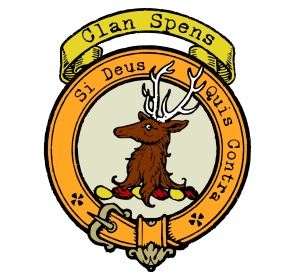Clan Spens
|
|
CREST: A hart’s head erased Proper MOTTO: Si deus quis contra TRANSLATION: If God is for us, who is against us VARIATIONS: N/A |
| The name “Spens” is believed to have originated from the Old French term “dispense,” signifying the custodian of a larder or pantry. It is suggested that the clan’s early members might have held this role within the monastic system. However, by the 13th century, we see the emergence of “Spensator Dispensa” as a term to describe royal officials, marking the transition of the clan from pantry keepers to influential figures in Scottish history.
The earliest recorded Spens, Roger “dispensator,” made his mark in 1232 by witnessing a deed that documented land transfers near Dallas in Inverness-shire. This was just the beginning of the clan’s ascent in Scottish society. John Spens served as Baillie of Irvine in 1260, further solidifying their presence in local governance. The Spens family’s journey to prominence took a significant turn in the 15th century when John Spens of Lathallan earned the right to sit in the Parliament convened by James I in Perth in 1434. His marriage to Isabel, the daughter of Sir John Wemyss, solidified his family’s connections in Scottish nobility. The Spens family also ventured beyond Scotland’s borders. Patrick Spens, the youngest son of John Spens of Lathallan, joined the Guard of Scots Archers sent by James II to Charles VII of France in 1450. His descendants went on to become the prominent Spens-Destinot de Lanere, famously serving as the personal bodyguard of the French kings for centuries, up until the French Revolution in 1789. Thomas Spens, another son of John Spens of Lathallan, pursued a different path. He entered the Church and rose to high office, becoming Bishop of Galloway and later Lord Privy Seal. His diplomatic skills were highly regarded, and he played crucial roles in various state negotiations, including marriage contracts and truces with England. The Spens family was not without its share of intriguing stories. During the reign of Mary, Queen of Scots, loyalties within the family were divided. Sir John Spence of Condie, who held the position of Lord Advocate, adhered to the reformed Church, while David Spens of Wormieston remained loyal to Mary and was involved in rebellious activities. The Spens family’s legacy extends into modern times. Some descendants have achieved prominence in academia, as seen in Dr. Nathaniel Spens, who served as the president of the Royal College of Physicians in 1794. Others have excelled in diverse fields, from university leadership to the realm of heraldry. |
|
Citations:
|
|
Purchase @ Redbubble
Purchase @ Amazon.com
Purchase @ Amazon.co.uk

